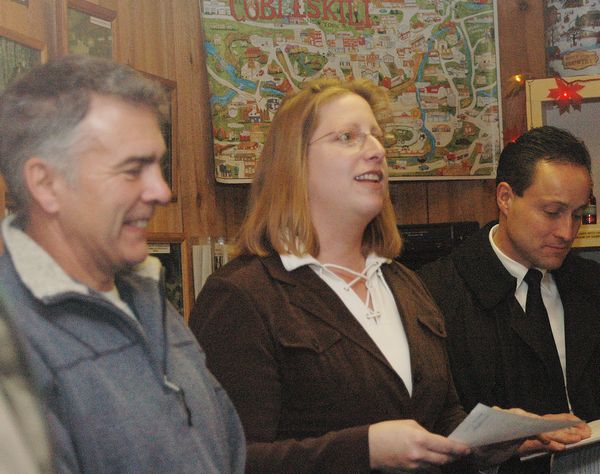Subscriptions
Menu
Advertisements
Biodiesel more than an alternative
11/20/2007 |
By Patsy Nicosia |

Biodiesel isn’t some “alternative energy” but rather a viable alternative to foreign oil with benefits not only to consumers but to the farm community as well.
That was the point made again and again at a tour of a half-dozen biodiesel facilities Friday hosted by Assemblyman Pete Lopez.
“This one of the rare instances where producers, farmers, environmentalists all want the same thing,” Assemblyman Lopez said in a question and answer session at SUNY Cobleskill.
“The question is how we can make it work in Albany.”
Biodiesel fuel is typically made from a wide range on sources, from waste restaurant cooking oil to crops like soy grown expressly for that purpose.
Most diesel vehicles can use some grade of biodiesel, though only the newest—like Assemblyman Lopez’s diesel Jeep Liberty—can use all of them.
Assemblyman Lopez gasses up at either the Mirabito Station on Carbon Street in Onenota or at John Ray and Sons at 6th Avenue in Troy; representatives from both accompanied about 30 others on Friday’s seven-stop tour.
First stop on the tour was Maple Hill Farm, Cobleskill, where Victor Putnam and Carolyn Foote have a contract for waste oil from the SUNY Oneonta dining hall to produce biodiesel for their own on-farm use.
The couple designed and built their processing plant from scratch and have the capacity of producing about 1,000 gallons of biodiesel weekly. Currently, they’re producing 250 gallons weekly during the summer only.
Mr. Putnam said there’s plenty of information about getting started in biodiesel available on the internet, but it only takes you so far; a lot of it is trial and error, he said, “and the learning curve is very steep. There are a lot of things you need to consider. You need to know what you’re dealing with.”
One consideration, Mr. Putnam said, is that below 40 degrees, biodiesel gels and is unusable—unless its cut with white kerosene.
Still, it’s a much cheaper process than ethanol, which relies on corn grown specifically for that process, he said.
“We can grow our own fuel right here. “We don’t need to go to war in some foreign country to defend it.”
Ms. Foote said the obstacles they ran into with things like financing and a lack of grant money only made them more determined to succeed.
“The biggest hindrance has been money,” she said, “but we’re passionate about this.”
At SUNY Cobleskill, Mirabito Fuels’ Jim Doi told about two dozen people, including farmers, cattle haulers, and representatives from the anti-Reunion Power Schoharie Valley Watch, that one of the keys now to seeing biodiesel succeed is education.
“It does work,” he said. “We’ve proven that. It can be a great thing for farmers…it’s time to move forward with this.”
Even at Mirabito, Mr. Doi said, it took a couple of years to sell what he called the “old guard” on the idea.
Right now, he said, they’re breaking even, largely because other comparable fuel sources like oil and coal are so heavily subsidized.
“If I could say it was cheaper, I don’t think I could keep it in the tank.
Anne Myers, SUNY Cobleskill president, said she believes people would be willing to pay more for biodisel if it was more readily available and understood “because it’s the right thing to do.”
Darius Benson, a Cobleskill cattle hauler, said plenty of the farmers he knows would be interested in using it if it was available for bulk delivery; still, though, there is the problem of it gelling at lower temperatures.
“But it’s non-toxic and biodegradable,” he said. “I like that.”
Both Mirabito and John Ray bring in their biodiesel as a soy product from Missouri and Florida, but Mr. Doi and Mr. Ray pointed out it would be more economical to use sources closer to home and that there’s a place for local agriculture in the process.
In answer to a question from the crowd, Mr. Doi characterized the growth in biodiesel as a “grassroots” effort that’s building from the ground up.
“There’s more private money in this than anything else I’ve come across,” he said.
In addition to the two Cobleskill stops, Friday’s tour also went to the Mirabito Station in Oneonta, the company’s bulk facility in Sidney, the Creative Energy Group Biodiesel Processing Plant in Bainbridge, the Chenango County Farm Bureau in Norwich, and the Giff Foster farm and biodiesel micro-plant in Bainbridge.









